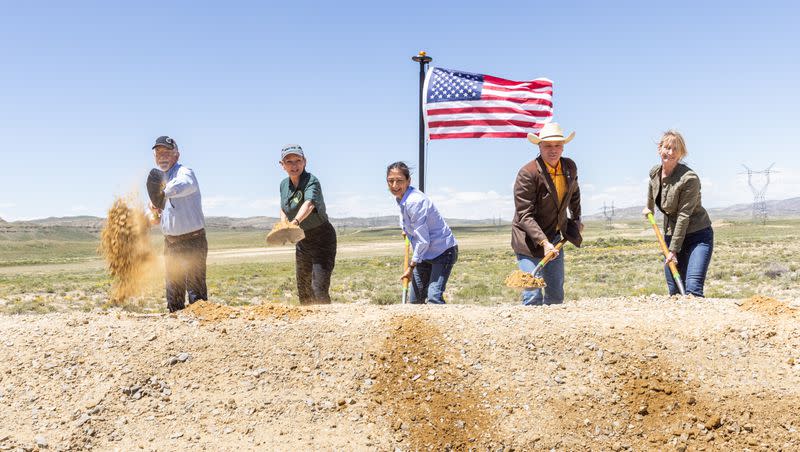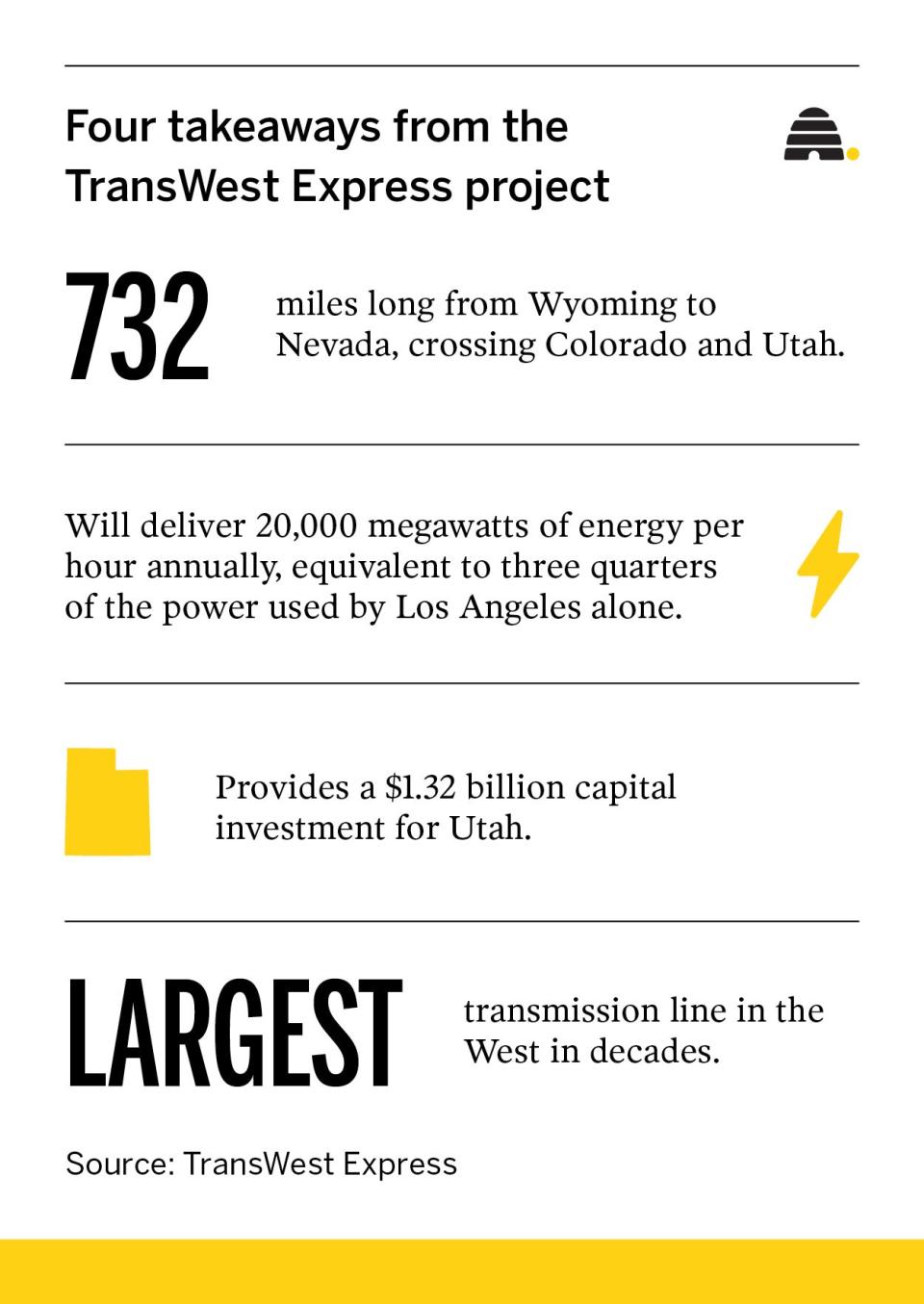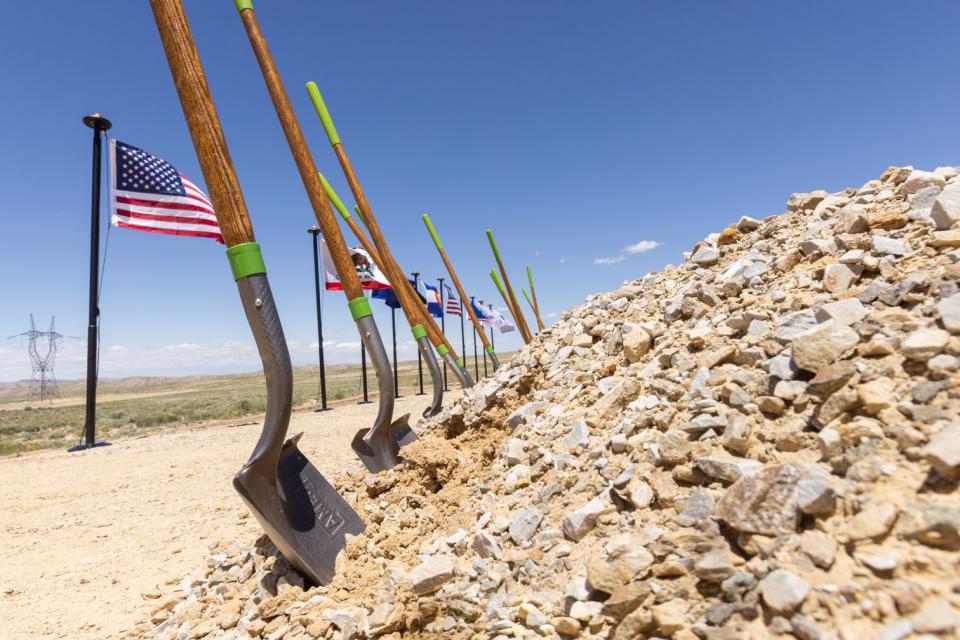What’s going on with the West’s largest transmission line in decades?

- Oops!Something went wrong.Please try again later.
It’s been 16 years since it was first proposed and it endured an eight-year environmental review process.
It will travel through Wyoming, Colorado, Utah and Nevada on a 732-mile route and generate energy that is roughly the equivalent of three-fourths of the power used in Los Angeles alone.
The TransWest Express high voltage transmission line, envisioned to be completed by 2027, is the largest transmission addition planned for the Western grid in decades.
In terms of renewable wind energy and bolstering the grid, it is a game changer, pumping 20,000 gigawatt hours of energy a year from a remote location in Wyoming to the desert Southwest.

Related
The magnitude of the project is what drove the attendance of two cabinet members in the Biden administration, the head of the Bureau of Land Management and representatives from multiple states to attend a groundbreaking ceremony in June.
“The TransWest Express Project will play a major role in our nation’s energy security, ensuring that home-grown clean energy can form the backbone of our electric grid as we rebuild a stronger, more resilient transmission system,” U.S. Secretary of Energy Jennifer Granholm said at the ceremony.
A joyous day here in Rawlins, Wyoming where @SecDebHaaland and I gathered with @GovernorGordon to celebrate the groundbreaking of @TWEProject.
TransWest's interregional transmission will provide dependable electricity for customers from WY to NV all the way to SoCal and AZ. pic.twitter.com/NBo7R0YvqW— Secretary Jennifer Granholm (@SecGranholm) June 20, 2023

The TransWest Express Project will connect three planning regions in the West, while adding 3,000 megawatts of high-voltage capacity from Wyoming to Utah and 1,500 megawatts from Utah to Nevada, California and Arizona. The project also will provide the West with new access to wind-generated electricity from Wyoming’s Carbon County, home of America’s best onshore wind resources.
It will interconnect with the PacifiCorp system in Wyoming with the Los Angeles Department of Water & Power and Intermountain Power systems in Utah, the NV Energy system in Nevada and with the California Independent System Operator.
“The TWE Project’s successful development represents recognition by stakeholders of all kinds and at all levels that collaborating to build a stronger power grid is vital to build a stronger nation,” said Bill Miller, president and chief executive officer of TransWest Express.
From its starting point in Sinclair, Wyoming, the direct current portion of the route travels south into eastern Colorado and jogs west into eastern Utah and then ultimately to Delta, where a new converter station will take the direct current and change it to alternating current before it ends south of Las Vegas.
Although it was marked as a high priority in 2011 for the Obama administration to fast track, the evolution of the project’s completion has been anything but fast as it has wound its way through a permitting process that has dragged on for years.
Related
A preliminary right of way application was initiated in November 2007, but it was not until April of this year federal regulators gave the go-ahead to begin construction for the transmission line — underscoring the painstakingly slow process that the Biden administration has vowed to change.
The $3 billion project includes a $1.32 billion capital investment in Utah, $477 million in property tax receipts paid out over 50 years and $47 million in sales and use taxes during the construction period.
Greg Todd, Utah’s director of the Office of Energy Development, was at the groundbreaking and was able to meet with a variety of federal representatives and others celebrating the milestone.
“It’s a big project. It took a lot of time, a long time, to get it to this point.”
Great to see Gregory Todd, Energy Advisor to UT @GovCox and Director of @UtahOED at the @TWEProject ground breaking. The project will invest
$1.32 billion in Utah and payout over
$477 million in property taxes to UT. The state of UT will also receive $47 M in sales and use… pic.twitter.com/JcutCAAEoe— The Western Way (@TWWPioneer) June 20, 2023
While Utah leaders have expressed concern in the past over all the energy going to other states, primarily California, and Utah not seeing any increased energy capacity from the line, TransWest Express spokeswoman Kara Choquette said that may not necessarily be the case.
Power Company of Wyoming will work with what Choquette describes as “off-takers” who are customers interested in inking power purchase agreements to receive some of that energy — and that could include Utah and any variety of other states with the infrastructure in place.
Related
Beyond the permitting approvals, TransWest Express had to negotiate compensation with private landowners reluctant to have the massive transmission line cross their property.
Choquette said ideally, the line would stay within the boundaries of already established utility corridors — but that was not always possible and not the route federal regulators chose.
In Utah, she said the total length of the line is 391 miles and of that, roughly 148 miles is private land, 32 miles is state, county or city-owned land and 211 miles crosses federal land.

